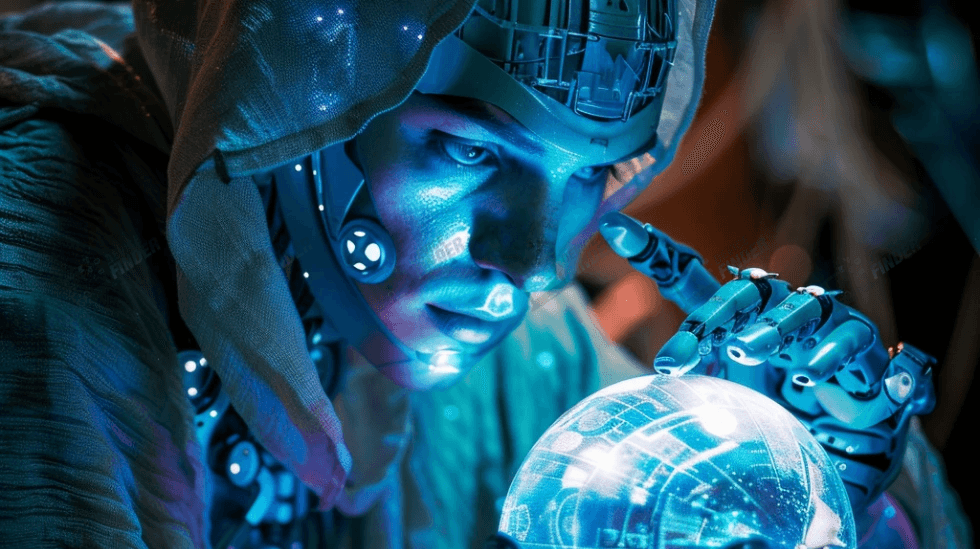
Can AI Predict the Future?
Artificial intelligence (AI) is changing the game everywhere. From banking to healthcare, AI is now part of our daily lives. People talk to an AI chatbot, use smart tools, and even let machines write reports. But now, AI has moved one step further. A UK startup called Mantic AI wants to show that machines can also predict the future.
Recently, Mantic AI joined a global contest called the Metaculus Cup in San Francisco. To everyone’s surprise, their system ranked 8th in the world. This is big news. For the first time, an AI system has beaten many skilled human experts in forecasting, showcasing the power of AI Predict in accurately anticipating complex outcomes.
The success of Mantic AI shows the rise of AI-power in a new area, future prediction. And for a country like Bangladesh, where floods, cyclones, and economic shifts are common, such technology could be life-changing.
Why Forecasting Matters
Forecasting means looking ahead and guessing what will happen. It is not just luck or guessing blindly. Forecasting uses facts, data, and patterns to give possible answers about the future.
For Bangladesh, forecasting is very important. The country is often hit by natural disasters like cyclones, floods, and river erosion. If we get accurate forecasts, people can move to safety in time, farmers can save their crops, and the government can plan disaster relief better.
Forecasts also matter in:
Economy: predicting inflation, exports, and dollar rates.
Healthcare: preparing for dengue, COVID-19, or seasonal diseases.
Politics: understanding public opinion before elections.
Farming: knowing about rainfall, soil health, and crop yields.
With AI, these forecasts could become sharper and faster. If we learn to work with AI, we can reduce risks and make smarter decisions.
The Metaculus Cup: A Test of Human vs. AI
The Metaculus Cup is a global forecasting competition. It is hosted by Metaculus, a platform where experts and AI systems share predictions.
The questions asked in this competition were tough. For example:
- Would Kemi Badenoch, leader of the UK Conservative Party, lose her post?
- Which political party would win the Samoa general election?
- How many acres would burn in the U.S. wildfires?
- How would public fights between Donald Trump and Elon Musk develop?
Thousands of humans took part. Yet Mantic AI still made it into the top 10. This shows AI is not just a helper anymore, it is a serious competitor to human forecasters.
How Mantic AI Works
Mantic AI does not use only one machine. Instead, it breaks big problems into small parts. Then, it gives each part to powerful AI systems created by OpenAI, Google, and DeepSeek. This method is like teamwork. One system looks at past data, another studies current events, and another checks global news. Together, the answers become stronger.
For example, when Google adds AI mode to its tools, it gives users better analysis. Mantic AI uses such upgrades along with other systems to build forecasts that are more reliable.
According to co-founder Toby Shevlane:
“Humans often stay near the average guess. But our AI is not afraid to give bold answers.”
This makes Mantic AI different. It dares to go beyond normal guesses, and sometimes that makes it more accurate.
Human Experts vs. AI
At present, human experts are still slightly ahead. Research by Philip Tetlock, author of Superforecasting, shows that skilled humans often beat machines at predictions. Humans can understand feelings, politics, and culture in ways AI cannot.
But things are changing. AI learns faster and can check millions of documents in seconds. Many experts believe that by 2029, AI forecasting will reach human level, or even pass it. When that happens, forecasting will no longer depend only on expert opinion. It will become a science powered by AI.
Why Bangladesh Needs AI Forecasting
Bangladesh has a lot to gain if it uses AI forecasting. Here are some key areas:
Disaster Management
Every year, millions face danger from cyclones and floods. AI can study weather data, river levels, and satellite images to give earlier warnings. This means more time for evacuation and less loss of life.
Economy and Trade
The economy depends on garments, remittances, and farming. AI forecasting could warn about global demand changes, currency shifts, and inflation. This would help businesses and the government prepare early.
Healthcare
During COVID-19, hospitals in Bangladesh struggled with patient numbers. AI can predict when cases may rise and which areas will need more care. An AI chatbot can also answer health questions, making information easier to access.
Politics
Elections are always important in Bangladesh. AI can study news, social media, and old election data to show likely trends. This could help parties and analysts understand what people want.
Farming
Farmers need weather information for planting and harvesting. AI can give accurate rainfall and crop predictions. This will reduce risks and improve food security. In short, AI can boost your day with AI, from cities to villages, by giving people the right information at the right time.
Challenges in Using AI Forecasting
Even though AI forecasting looks powerful, it faces problems too.
Data quality: In Bangladesh, records are often incomplete or wrong.
Human behavior: People act emotionally, and AI cannot always predict that.
Trust issues: Many may not trust machines for serious decisions like elections.
Cost: Running big AI models needs money, power, and skilled workers.
Without solving these problems, AI forecasts may not work as well as expected.
The Future of Forecasting
The future of forecasting is moving quickly. Tech companies are adding more predictive features. For example, when Google adds AI mode in its apps, it helps users make faster choices. Bangladesh can also prepare for this future. If the government, businesses, and schools start using AI forecasting, the country can:
- Respond better to disasters.
- Grow the economy with smart planning.
- Support farmers with weather data.
- Guide healthcare during epidemics.
This is the clear sign of the rise of AI-power. Countries that use it will move ahead, while others may fall behind.
Conclusion
Mantic AI’s success in the Metaculus Cup proves one thing: AI can compete with human experts. Today, humans are still slightly better. But soon, AI may become the leader. For Bangladesh, this is a huge opportunity. Accurate forecasting could save lives during disasters, protect farmers, and prepare the economy for global shifts. The question is not if AI will predict the future. The question is when we will be ready to use it. If Bangladesh chooses to work with AI, it can shape a safer and smarter tomorrow.
Frequently Asked Questions (FAQs)
1. What is AI forecasting?
It means using AI to study data and predict future events.
2. How did Mantic AI perform in the global contest?
It ranked 8th in the Metaculus Cup, beating many human experts.
3. Can AI help Bangladesh?
Yes. It can help in disasters, farming, healthcare, economy, and politics.
4. Are humans better than AI now?
Yes, but only slightly. By 2029, AI may become equal or better.
5. How can people use AI daily?
By using apps where Google adds AI mode or by chatting with an AI chatbot. These tools can boost your day with AI.









